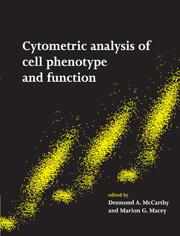Book contents
- Frontmatter
- Contents
- List of contributors
- List of abbreviations
- 1 Principles of flow cytometry
- 2 Introduction to the general principles of sample preparation
- 3 Fluorescence and fluorochromes
- 4 Quality control in flow cytometry
- 5 Data analysis in flow cytometry
- 6 Laser scanning cytometry: application to the immunophenotyping of hematological malignancies
- 7 Leukocyte immunobiology
- 8 Immunophenotypic analysis of leukocytes in disease
- 9 Analysis and isolation of minor cell populations
- 10 Cell cycle, DNA and DNA ploidy analysis
- 11 Cell viability, necrosis and apoptosis
- 12 Phagocyte biology and function
- 13 Intracellular measures of signalling pathways
- 14 Cell–cell interactions
- 15 Nucleic acids
- 16 Microbial infections
- 17 Leucocyte cell surface antigens
- 18 Recent and future developments: conclusions
- Appendix
- Index
- Plate section
5 - Data analysis in flow cytometry
Published online by Cambridge University Press: 06 January 2010
- Frontmatter
- Contents
- List of contributors
- List of abbreviations
- 1 Principles of flow cytometry
- 2 Introduction to the general principles of sample preparation
- 3 Fluorescence and fluorochromes
- 4 Quality control in flow cytometry
- 5 Data analysis in flow cytometry
- 6 Laser scanning cytometry: application to the immunophenotyping of hematological malignancies
- 7 Leukocyte immunobiology
- 8 Immunophenotypic analysis of leukocytes in disease
- 9 Analysis and isolation of minor cell populations
- 10 Cell cycle, DNA and DNA ploidy analysis
- 11 Cell viability, necrosis and apoptosis
- 12 Phagocyte biology and function
- 13 Intracellular measures of signalling pathways
- 14 Cell–cell interactions
- 15 Nucleic acids
- 16 Microbial infections
- 17 Leucocyte cell surface antigens
- 18 Recent and future developments: conclusions
- Appendix
- Index
- Plate section
Summary
Introduction
Errors in flow cytometry can only arise from two discrete processes: data acquisition and data analysis. In general, data acquisition errors can be avoided by good sample preparation and accurate instrument set-up. Quality assurance reagents are available to confirm most aspects of sample preparation in routine applications and internal experimental controls should be designed to provide the same level of assurance in experimental applications. Instrument standards, such as fluorescent beads or fixed nuclei, can be used to confirm instrument performance in both settings. The only aspect of data acquisition for which controls are unavailable is the ability of the operator to design the correct experiment. This is obviously common to any analytical procedure but is particularly relevant to applications such as flow cytometry where the only output is a digitised signal presented on a computer screen.
Experiment design
The most common acquisition error made by users of flow cytometers is insufficient data points. Often huge files of list mode data are collected, sometimes with tens of thousands of data points, which, upon analysis, contain mostly debris or irrelevant cells. This is an easily avoided error. The traditional way to guarantee the acquisition of a specific number of cells of interest is to apply an acquisition gate or region based upon one or more characteristics of the cells of interest. This is effective but limits the data analysis solely to the cells that were thought to be of interest at the time of analysis and necessarily excludes any other cell populations that may be of interest subsequently. A more flexible approach requires setting an acquisition region or gate that is used solely for counting.
Information
- Type
- Chapter
- Information
- Cytometric Analysis of Cell Phenotype and Function , pp. 89 - 99Publisher: Cambridge University PressPrint publication year: 2001
Accessibility standard: Unknown
Why this information is here
This section outlines the accessibility features of this content - including support for screen readers, full keyboard navigation and high-contrast display options. This may not be relevant for you.Accessibility Information
- 1
- Cited by
